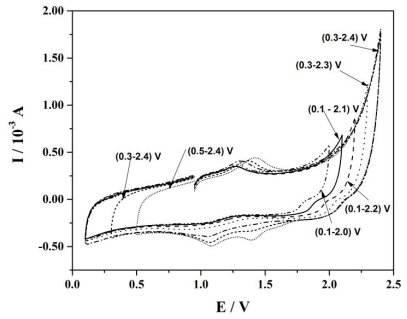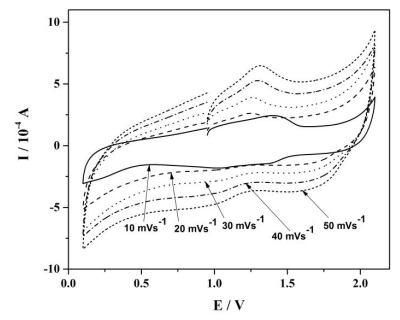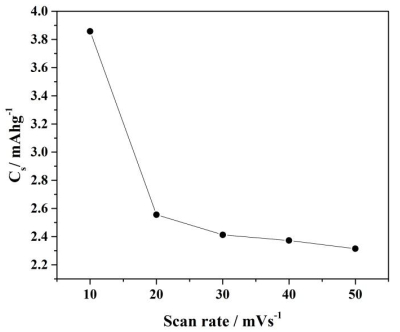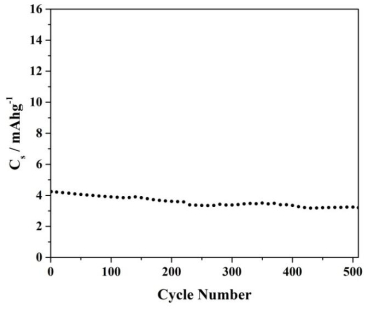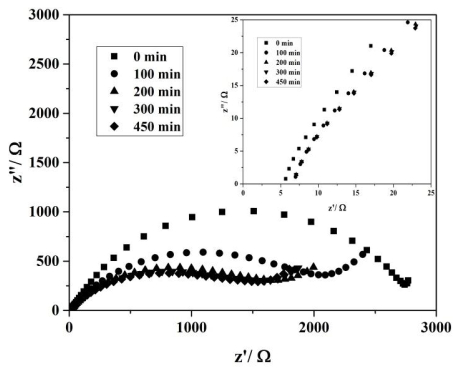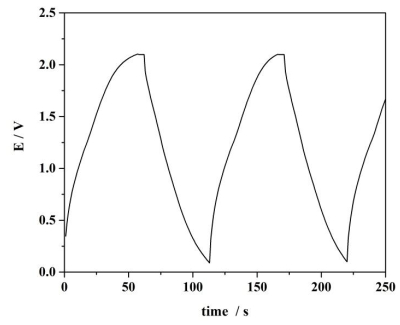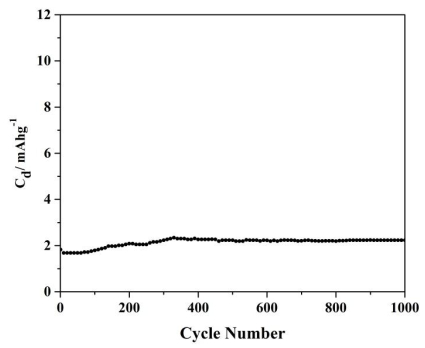1. Introduction
Due to the unending rapid demand for energy in the modern technological society in various aspects, the whole globe is heading towards an enormous energy crisis. On the other hand, within the next few years, there can be huge challenges to maintain the green environment with the disposal of used power devices which are mainly based on Li. At present, it has been well accepted that Li is significantly a dangerous material even though it possess outstanding performance [1,2]. In addition, presence of liquid electrolytes in many devices available in the present day market is also supposed to create some environmental threats. These issues have laid the foundation to seek materials which are safe and low cost to fabricate devices. In place of Li, materials like Mg, Cu, Zn and Al have been identified as suitable substitutes for anodes with remarkable features [3,4,5]. On the other hand, natural graphite has a growing attention to be used in place of Li based composite cathodes. Some have carried out investigations using graphite in electrochemical cells and supercapcitors [6,7,8]. Gel polymer electrolytes (GPEs) have received a major consideration to be employed in various applications to surmount many of the traditional drawbacks of liquid and solid polymer electrolytes [9,10]. In a GPE, a salt/solvent mixture is assumed to be encapsulated inside a polymer host. They possess ionic conductivities similar to liquid electrolytes in the order of 10–3 Scm–1 [11,12]. Their ionic transference numbers are above 0.9. But, the presence of solvents has given rise to some limitations with respect to safety. This has motivated the interest on replacing solvents by ionic liquid (IL)s which are present as room temperature molten salts. They possess some unique properties such as low toxicity, wide electrochemical stability, high thermal stability, etc. [13]. These ILs are being considered as an innovative approach to avoid many drawbacks of solvents. As such, IL based GPEs are also receiving a considerable attention to be employed for applications [14]. Due to the unrelenting increase in the curiosity towards non Li systems, non Li salts have been incorporated in preparing IL based GPEs. They have been eventually exploit for a diverse range of uses [15,16].
In the present study, cells have been fabricated with the configuration of Zn/IL based GPE/graphite. It is a known fact that Zn is abundant and cheap. Also, it is not toxic as Li. Zn has a high stability as well as satisfactory volumetric and specific density. The graphite electrodes were prepared using Sri Lankan natural graphite. In Sri Lanka, graphite has been renowned as one of the valuable natural resources. But, it has not been properly employed for applications in energy sector. Use of natural graphite provides much safety and also, it is not expensive. The main highlight of the present study is use of Zn and Sri Lankan natural graphite electrodes with an IL based GPE in a rechargeable cell. The average open circuit voltage (OCV) of the cells were 1 V. The stability, charge/discharge characteristics of the cells were determined by electrochemical impedance spectroscopy (EIS), cyclic voltammetry (CV) as well as continuous charge discharge (GCD) test.
2. Materials and methods
2.1. Preparation of IL based GPE
Electrolyte was prepared using solvent casting technique. Poly (vinylidinefluoride-co-hydrofluoropropylene) (PVdF-co-HFP, average MW 400000), zinc trifluoromethanesulfonate (Zn(CF3SO3)2-ZnTF, 98%) and 1-ethyl-3-methylimidazoliumtrifluoromethanesulfonate (1E3MITF, 98%) were received from Aldrich. ZnTf was vacuum dried at 120 ℃ for 24 hours. Required amount of PVdF-co-HFP was first magnetically stirred with acetone at room temperature (RT) until PVdF-co-HFP dissolves in acetone. ZnTF and 1E3MITF were added to the resultant mixture and magnetically stirred again overnight. Before mixing, IL was vasuum dried at 120 ℃ for 12 hours. Homogeneous solution was then poured in to a glass petri dish and it was kept in a vacuum desiccator overnight to evaporate acetone. Film was then vacuum dried at 80 ℃ for 8 hours. Finally it was possible to obtain a thin, free standing film with no bubbles and pin holes. The composition of the electrolyte was 1 PVdF:1 ZnTf:3 IL (by weight basis).
2.2. Fabrication of rechargeable cells
A circular shaped, well cleaned Zn pellet was used as one electrode (area 1 cm2). For the other electrode, natural graphite obtained from Bogala Graphite Lanka, Sri Lanka was pre heated to 150 ℃ and was dissolved in acetone using a homogenizer. Then the resulted homogeneous mixture was coated on the surface of a stainless steel (SS) disk (area 1 cm2) evenly and dried well in a vacuum oven for 12 hours. Then, a circular shaped (area 1 cm2) electrolyte was sandwiched between Zn and graphite electrodes. Thicknesses of the Zn electrode, graphite electrode and the electrolyte film were 0.25 mm, 0.30 mm and 0.40 mm respectively. Cell assembly was loaded inside a brass sample holder.
2.3. Performance evaluation of rechargeable cells
Open circuit voltage (OCV) of the cell was measured using a digital multimeter at different time durations. Cyclic voltammetry studies were carried out using a three electrode electrochemical setup using Metrohm AutoLab potetniostat. Graphite electrode was used as the working electrode while Zn electrode was used as the reference and counter electrode. Voltage window of the cyclic voltammogramme was changed to trace the optimum window that results the highest specific charge (Cs). Cycling was done at the scan rate of 10 mVs–1. Cs was calculated using the Eq 1,
where ∫IdV is the area of CV, Dv is the potential window and S is the scan rate.
Then, cycling was done in that potential window varying the scan rate to determine the corresponding scan rate for the optimum Cs. Thereafter, continuous cycling was carried out to check the stability of the cell.
Impedance measurements of the cell were gathered using an Impedance Analyzer (Metrohm AutoLabM101) at different time durations in the frequency range from 0.1 Hz to 400 kHz.
Galvanostatic charge discharge (GCD) test was performed between 0.1 V and 2.1 V for the cell at room temperature under a constant current of 500 µA. Study was done for 1000 GCD cycles and the discharge capacity (Cd) was calculated by the Eq 2:
where, I is the constant current and dt is the time duration for discharge.
3. Results and discussion
3.1. Open circuit voltage variation
Figure 1 shows the variation of the OCV for the rechargeable cell, Zn/IL based GPE/graphite. As soon as fabrication, the OCV value was 1.10 V. According to the results, the initial value remains constant throughout the investigation. This elucidates the fact that there are no reactions taking place inside the cell. There is a high probability for the occurance of parasitic reactions such as electrode/electrolyte reactions, formation of some interfaces which hinder the efficiency of cell performance [17]. If there were such reactions, they affect OCV and hence, a reduction of OCV with time should be observed. Basically, those reactions are possibly occurring at the electrolyte/electrode interfaces. Thus, the results prove the stability at the interfaces. This would be due to the absence of any reactive material in the cell. Zn and graphite are known to be safer materials with low reactivity. On the other hand, electrolyte does not contain any solvent which is very aggressive with materials. This confirms the user friendly nature of IL based GPEs as well as Zn/graphite electrodes.
3.2. Cyclic voltammetry
The cyclic voltammogrammes obtained by varying the voltage window are shown in Figure 2.
The widest voltage window was from 0.1 to 2.4 V. According to the results of the present study, the highest value of Cs could be obtained from that voltage window. But when the upper vertex goes to higher values than 2.1 V, cell started to get destroyed as evidenced by the high current. Thus, as the most suitable window, the range from 0.1 to 2.1 V was chosen. Within this window, cycling was done at different scan rates and it is shown in Figure 3.
Peaks appearing in the CVs are proving the ion movement that takes place at charge discharge processes of the cell. The peaks at positive side of the current axis are due to charging while negative side are due to discharging. In the present cell, Zn ions are playing a major role in the cell operation. As such, they are getting plated and stripped during charge discharge process [12].
When considering the scan rate variation, higher scan rates resulted lower Cs values. This is illustrated in Figure 4.
During cycling at a particular scan rate, the ions move between electrodes due to charging and discharging processes. Occurrence of complete cell reactions is highly needed to get high Cs values. This is facilitated by lower scan rates that would allow sufficient time for proper reactions to take place [18]. The scan rate of 10 mVs–1 was selected as the optimum scan rate for further studies.
Ability of the cell to withstand continuous cycling was monitored upon performing continuous cycling and it is shown in Figure 5.
At the first cycle, the cell has a Cs value of 4.23 mAhg–1. It decreased down to 3.20 mAhg–1 during 500 cycles. The reduction of Cs is about 24% which is quite small. This highlights the satisfactory compatibility between GPE and electrodes as evidenced by OCV variation with time [19].
3.3. Electrochemcial Impedance Spectroscopy (EIS)
Figure 6 illustrates several Nyquist plots taken at different time periods. The intercept in the high frequency region represents the bulk electrolyte resistance (Rb) whereas the other intercept in the mid frequency region represents charge transfer resistance (Rct) at the electrolyte/electrode interface [20]. According to the results, it is seen that initial Rct value has dropped with time. Higher Rct at the beginning may be due to the improper contacts at the interface of the electrolyte and the electrodes that lead to high resistance for charge transfer. As time passes, those interfaces may become stable and mature. Rb remains rather constant as shown in the inset. This well proves the stability of the electrolyte. If there were solvents in the system, there is a possibility for solvent evaporation which increases Rb considerably. Salt and IL present in the system may reside in with the polymer without affecting the electrolyte resistance.
3.4. Galvanostatic charge discharge test
Initial galvanostatic charge discharge cycles obtained for the cell under a constant current of 500 µA is shown in Figure 7.
Variation of the discharge capacity, Cd of the cell with cycle number is shown in Figure 8.
The initial Cd value is 1.82 mAhg–1. Upon continuous charge-discharge cycling, Cd increases first and thereafter, it reaches to a stable value of 2.2 mAhg–1 after about 300 cycles. This suggests that the cell needs some time to reach the maturity [21]. Soon after fabrication, it is not in a state to function in the proper level. The interfaces may not be formed properly to allow respective ion movements initially as evidenced by Rct value obtained from Nyquist plots in Figure 6. As time passes, those interfaces may become stabilized and then, complete reactions may take place. This makes Cd more or less constant.
4. Conclusions
The GPE consisting of PVdF-co-HFP, 1E3MITF and ZnTF is prepared by solvent casting technique with optimized ratio of 1:1:3 by weight basis. OCV value of the cell Zn/IL based GPE/graphite remained constant around 1.10 V. Optimized voltage window of this cell was from 0.1 V to 2.1 V and the scan rate was 10 mVs–1. The Cs value of the cell was 4.23 mAhg–1 and its reduction was 24% for 500 cycles. Moreover, it showed a Cd value of 1.82 mAhg–1 and it was stable at 2.2 mAhg–1 after 300 cycles. Results showcase the suitability of this cell for applications. Further studies are being conducted to improve the performance for moving towards prototype and commercial stages.
Acknowledgements
Authors wish to acknowledge the assistance given by National Science Foundation, Sri Lanka under the grants, RG/2017/BS/02 and RG/2015/EQ/07. In addition, Wayamba University of Sri Lanka is greatly acknowledged for the award of the research grant, SRHDC/RP/04/17/01.
Conflict of interest
All authors declare no conflicts of interest in this paper.









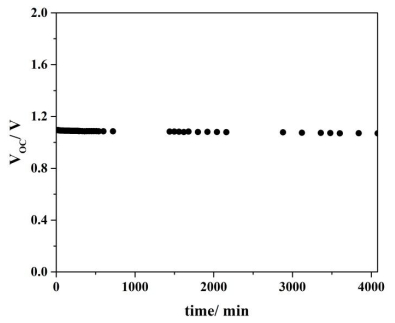
 DownLoad:
DownLoad: 